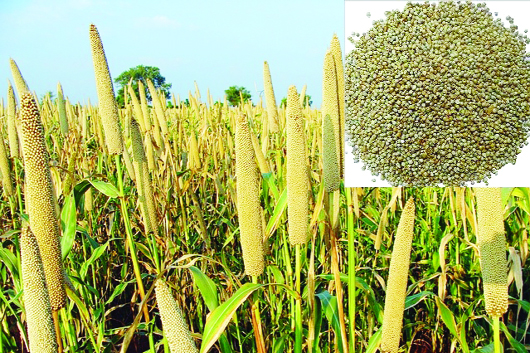Arun Kumar Shrivastav
Thanking Indian Prime Minister Narendra Modi on December 27 for getting the UNO to announce 2023 as the International Year of Millets, Haryana Chief Minister Manohar Lal Khattar said, “The more the practice of eating millets increases, the more the side effects of crops produced by chemicals will reduce.” As it appears, Indian government ministries, parliamentarians, Indian diplomatic missions abroad, and bureaucrats are promoting the production and consumption of millet in a concerted manner. Celebrities and startups are also being roped in to be part of this year-long program.
Millets are a group of cereals that include more popular grains – Jowar (Sorghum), Bajra (pearl millet), and Ragi (finger millet). These grains are still less genetically-modified and are gluten-free, unlike wheat and rice. Thanks to these properties, millets are nutritious and a good option for people with diabetes. Millets are staples in many parts of India and globally, but mostly in rural areas. Because of its high nutritional value, millet is supposed to be particularly good for women and children, who often neglect eating properly and adequately. But because of their strong earthy flavour, relatively higher fibre, and absence of gluten that makes other cereals taste sweeter than millet, these golden cereals have been relegated from mainstream food habits.
On December 20, the Prime Minister shared four pictures on Twitter of a sumptuous lunch in Parliament where millet dishes were served in a precursor to the International Year of Millets. Parliamentarians across party lines joined the savory event, he remarked. Three days later, the Ministry of Railways said it was serving “millet-enriched high-end delicacies” on the Gandhinagar Capital – Mumbai Central Vande Bharat Express. It appeared on a recent Big Boss Tamil episode and the audience was informed about how India sponsored the resolution and got it passed to declare 2023 as the International Year of Millets.
Union Minister of State for Agriculture and Farmers Welfare Shobha Karandlaje followed up by highlighting the benefits of growing millets. She said, “Millets are resistant to harsh weather conditions and produce abundantly. Farmers can raise these cereals in any environment, condition, or setting without spending on inputs. International Year of Millets will increase their market Value.”
Ministry of Women and Child Development in a post enumerated the benefits of millets: They contain anti-diabetic properties; reduce hypertension, induce the production of detoxifying enzymes; aid in sleep; and manage obesity. G20 India meetings also premiered a video presentation on millet production and processing. Millets are climate-smart and nutritious crops grown by over 85% of small farmers in India, it said through its official Twitter account.
In the last 24 hours, several celebrities and government bodies have come out with their promotions for millet. For example, Odisha Millet Mission organized a talk by noted Odia film personality Nila Madhab Panda on the millets’ nutritional benefits and the role they can plan in building resilience against climate change. The Government of India has launched a new Twitter handle International Year Of Millets 2023. In its first tweet, it said, “Celebration of International Year of Millets 2023 will pave the way for strengthening the entire millets value chain and lead to enhanced production, consumption, and export.”
G20 Sherpa and former CEO of NITI Aayog Amitabh Kant informed about millet-based meals and millet boxes as parting gifts for delegates in the recently-concluded first G20 meetings under the presidency of India last week. On December 23, the multi-edition business and finance daily Business Standard carried a report with the headline “What has made Odisha Millets Mission a success in such a short time.” The report lays stress on how this initiative has helped thousands of farmers choose a path of relatively higher income.
On December 26, Karandlaje shared two pictures of a police officer gulping down a millet smoothie from a glass bowl and finishing it off with the help of a spoon. She writes, “It’s indeed encouraging to see a police officer incorporate millets into his diet and make them part of his dietary practice. Millets have all the nutrients and can serve as one of the finest supplements for athletes.”
Millet may not be a staple in mainstream India but it’s a much-loved cereal in rural India and more so in the hilly regions. Nepali food blogger Sanjib Chaudhary shared two pictures on Twitter of native dishes made with millet and corn flours – Selroti and Dhindo and ask his followers to promote native dishes. Similarly, millet lovers from all over the world are posting their best millet dishes and messages on Twitter. The trend is likely to get stronger and bring millet growes in sharp international focus.
An article in the New Indian Express on December 25 talks about a millet-inspired farm-to-plate startup – Prima Farm. It runs a cloud kitchen and provides millet-based alternatives for breakfast, lunch, and dinner. The report says options are galore – ragi samosa, millet momos, ragidosa, ragi vegetable uttapam, paratha, chapatti, and dry-fruit laced millet cakes. Millets are Gluten free and have a strong earthy flavor. However, culinary experts at this startup ensure the millet dishes are tasty and leave you craving for more, the coverage says.
Welcome to the International Year of Millets 2023! (IPA)
Trending Now
E-Paper


